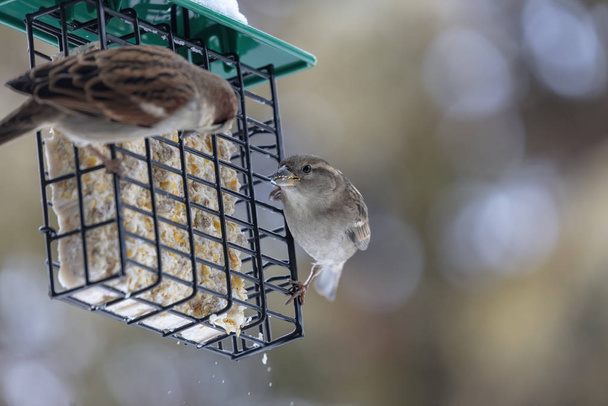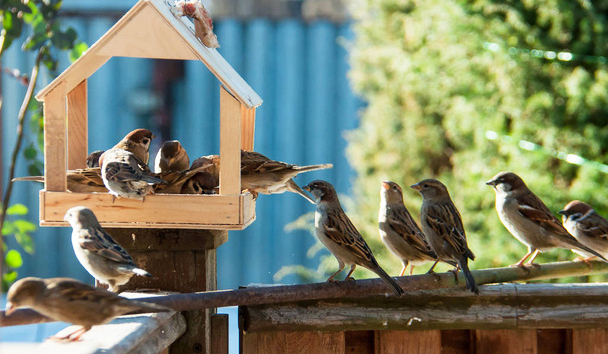Beneath the Thatched Roof: The Sparrow's Vanishing Song
For those of us whose ancestral roots lie in the rural heart of Odisha, there is a profound sense of nostalgia for humble mud houses with thatched roofs. These homes, designed with a perfect blend of simplicity and function, embrace open spaces more than enclosed ones. Verandas and porticos are as much a part of the structure as the rooms within. Though small, they possess an expansive warmth that can comfortably house a family of over twenty members. These homes were not merely shelters for people, but sanctuaries for domestic animals and birds alike. The boundaries of these village homes extend beyond walls to include cattle sheds, kennels for dogs and cats, towering trees, ponds, gardens and what not. A home in rural India is not just a living space for people to eat, sleep and relax but a space where you feel alive with nature. In those lively environments there used to live a little bird. This bird lived in perfect symbiosis with the humans and animals of the household. Its voice, as enchanting as its tiny form, brought a sense of vibrancy to the silent, sunlit afternoons of summer. It generally nests in those thatched roofs of the houses or in those trees within campus. As it flits about the property adding a joyful cadence to the air, it gives an illusion of a small kid, vivaciously playing around the house. The bird is Sparrow, also known as Ghar-Chattia in local Odia language, meaning the small bird (Chattia) that lives in the house (Ghar).
These small yet resilient birds, once a common sight across India, including Odisha, have seen a drastic decline in their population due to urbanization, habitat destruction, pollution, and climate change. The dwindling population of house sparrows (Passer doamesticus) should be a matter of concern. While sparrows may not be classified as endangered, their disappearance from urban and rural landscapes is indicative of larger environmental issues, such as air pollution, loss of green cover, and the harmful impacts of modern infrastructure.
Sparrows are not just another species of birds; they are bio-indicators of environmental health. Their presence in an area reflects the quality of air, the availability of food sources, and the state of urban biodiversity. Sparrows play an essential role in pest Control as they feed on insects and larvae, helping control pest populations that affect crops and plants. Though not primary pollinators, sparrows contribute to the dispersal of seeds, supporting plant growth and regeneration. They consume and excrete seeds, helping to disperse plant seeds and promote vegetation.
Beyond their ecological importance, sparrows hold cultural and emotional significance in India. They have been a part of folklore, poetry, and daily life for generations. Their cheerful chirping was once a morning symphony in homes and gardens, but their absence today signals the adverse effects of rapid modernization.

World Sparrow Day is observed annually on March 20, with the first celebration taken place on this date in 2010. In India, the initiative was launched by The Nature Forever Society, founded by the renowned conservationist Mohammed Dilawar, to raise awareness about the importance of protecting house sparrows and other common bird species. This day serves as a poignant reminder of the fragile balance within our ecosystems and the vital role that even the smallest creatures play in sustaining it.
The drastic decline in sparrow numbers is a consequence of multiple environmental and human-induced factors. Some of the most significant threats include urbanization and habitat destruction. Rapid urban expansion in cities like Bhubaneswar, Cuttack, Rourkela, and Sambalpur has led to the loss of old buildings, gardens, and open spaces where sparrows once thrived. Modern architecture, which relies on glass and concrete structures, does not provide the nooks and crannies that sparrows use for nesting.

Increasing vehicular emissions and industrial pollution have contaminated the air, making urban areas less hospitable for small birds. Additionally, excessive noise pollution from traffic, construction, and loudspeakers disrupts the bird’s communication and breeding patterns. Scientific studies suggest that radiation from mobile phone towers interferes with the navigational abilities of birds, including sparrows. With the rapid expansion of telecom networks in both urban and rural Odisha, the electromagnetic interference has become an additional stressor for these birds.
Similarly, changing agricultural practices, widespread use of pesticides and chemical fertilizers has severely reduced the availability of insects, a primary food source for sparrows. In rural areas of Odisha, where sparrows were once abundant, large-scale mechanized farming and hybrid crop varieties have negatively impacted their survival.
Finally, the introduction of invasive bird species, such as pigeons and mynas, has increased competition for food and nesting sites, further pushing sparrows to the margins. Additionally, an increase in the population of house cats and stray dogs has added to the predation pressure on these small birds.
Recognizing the alarming decline of sparrow populations, conservation efforts across India are striving to restore their numbers, ensuring that future generations continue to hear the familiar chirping of these tiny yet vital birds. Some notable initiatives working towards sparrow conservation are: Rabindranath Sahu (Odisha), A conservationist from Puranabandha village of Ganjam district, has expanded sparrow conservation across more than 17 districts in Odisha by mobilizing local communities. Similarly, Subrat Nath, an engineer from Sambalpur, revived sparrows in his area by installing earthen nests and hanging paddy stalks. He also distributes sparrow nests to encourage community involvement.
Initiatives such as Save Our Sparrow (SOS) by Burhani Foundation(2011) have distributed over 52,000 bird feeders worldwide, earning a Guinness World Record. Another initiative Mor Chiriya (2022) Launched by the Mahasamund forest division, Chhattisgarh is a community-driven initiative focused on sparrow conservation through public participation.
Some other bird conservation strategies emphasizing habitat restoration, afforestation, and community-driven conservation efforts have been undertaken by National Biodiversity Action Plan (NBAP) under the aegis of The Ministry of Environment, Forest, and Climate Change (MoEF&CC); National Action Plan for Conservation of Migratory Birds; Ama Jungle Yojana and the Mukhyamantri Green Mahanadi Mission by the Odisha Forest Department. The Bhubaneswar Smart City project has incorporated biodiversity-friendly infrastructure, encouraging green rooftops, vertical gardens, and urban parks that support bird habitats. Similarly, Odisha Biodiversity Board has been conducting studies on urban biodiversity along with several non-governmental organizations (NGOs) and community groups like Wildlife Society of Odisha, and The Indian Bird Conservation Network among others, who are working on community participation and sustainable conservation strategies. The most effective conservation efforts are those that involve local communities. Encouraging citizens to take simple steps can go a long way in reviving sparrow populations.
Some of the simple steps that could be taken by common people in the urban settings are, Installing nest boxes and bird feeders in balconies, gardens, and public spaces. These provide safe nesting spots and a reliable source of food, especially in urban environments. Secondly, promoting native plants and green spaces, flowering trees in home gardens, parks, and office spaces can create a more hospitable environment for sparrows. Neem, Peepal, Banyan, and Hibiscus are some plant species that attract insects, providing a natural food source for birds. Thirdly, reducing pesticide use farmers and gardeners should be encouraged to use organic fertilizers and natural pest control methods to maintain ecological balance. Community participation in bird monitoring programs, such as eBird India can help track sparrow populations and identify regions where conservation efforts are needed. Schools and colleges can organize ‘Sparrow Census’ initiatives to engage students in conservation efforts.
Sparrow conservation is not just about saving a single species; it is about ensuring a healthy, sustainable environment for all living beings. The decline of sparrows is a warning sign that demands immediate action to restore urban biodiversity and promote environmentally responsible practices.
World Sparrow Day serves as a reminder that every individual whether a policy maker, conservationist, student, or citizen could contribute to the preservation of these small yet vital birds. By integrating government initiatives, community-driven efforts, and sustainable urban planning, we can bring back the chirping of sparrows to our homes and cities, ensuring that future generations continue to experience the joy and ecological benefits these birds provide.





 copy.jpg)